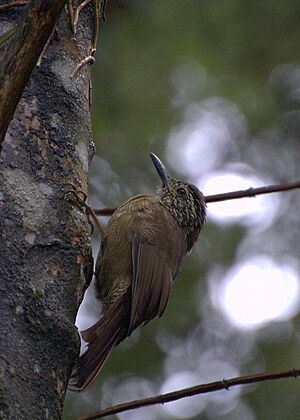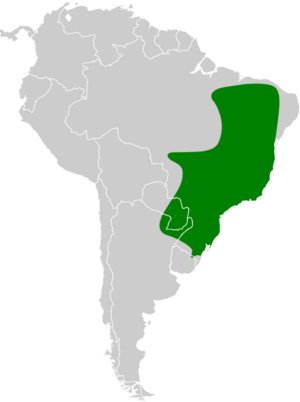Planalto woodcreeper facts for kids
Quick facts for kids Planalto woodcreeper |
|
|---|---|
 |
|
| Conservation status | |
| Scientific classification | |
| Genus: |
Dendrocolaptes
|
| Species: |
platyrostris
|
 |
|
The planalto woodcreeper (Dendrocolaptes platyrostris) is a type of bird found in South America. It lives in countries like Argentina, Brazil, Paraguay, and Uruguay. This bird belongs to a group called woodcreepers, which are known for climbing trees.
Contents
About the Planalto Woodcreeper
Family Tree and Relatives
The planalto woodcreeper is closely related to other woodcreepers. These include the black-banded woodcreeper and Hoffmanns's woodcreeper. Some scientists even thought they might be the same species!
There are two main types, or subspecies, of the planalto woodcreeper. They are called D. p. platyrostris and D. p. intermedius. While they look a bit different and sing different songs, they are still considered the same species.
What Does It Look Like?
The planalto woodcreeper is one of the bigger woodcreepers. It has a slim body and a long tail. Its bill, or beak, is straight and medium-sized.
This bird is about 25 to 27 centimeters (10 to 11 inches) long. It weighs between 43 and 69 grams (1.5 to 2.4 ounces). Both male and female birds look the same.
Their faces are dark with light streaks. The top of their head and neck are black with bold, light stripes. Their back is olive-brown with thin streaks. Their wings and tail are a dull reddish-brown color.
Their throat is whitish with some faint marks. Their chest is olive-brown with strong light streaks. The belly and sides are brownish with thin dark bars. Their eyes are brown, and their bill is usually black.
The two types of planalto woodcreepers have slightly different colors. One type is paler and more cinnamon-colored. But where they meet, their colors blend together.
Where They Live and What They Eat
Where to Find Them
The planalto woodcreeper lives in different parts of South America. The D. p. platyrostris type lives more to the south. You can find it in eastern and southeastern Brazil, down into northeastern Argentina and a tiny bit of Uruguay.
The D. p. intermedius type lives further north and west. It is found in central and south-central Brazil and eastern Paraguay. Both types can be found all the way to the Atlantic coast.
Their Home Environment
These birds live in many kinds of wooded areas. The southern type prefers humid forests, both in lowlands and on mountains. The northern type lives in drier places. These include forests that lose their leaves, palm swamps, and forests along rivers.
They like to stay deep inside untouched forests. However, they can also be seen at the edges of these forests. They also live in older forests that have grown back after being disturbed.
Behavior and Life Cycle
Staying in One Place
The planalto woodcreeper does not migrate. It stays in the same area all year round.
What They Eat
These birds mainly eat arthropods. Arthropods are creatures like insects and spiders. They also sometimes eat small animals like frogs. A small part of their diet is plants.
They often follow groups of army ants. These ants stir up insects, making them easy to catch. The woodcreeper will perch low and quickly fly out to grab its prey. When not with ants, they look for food at all levels of the forest. They might fly from a perch to catch something or pick food off leaves and tree bark.
Reproduction and Nests
The breeding season for the planalto woodcreeper usually happens between October and January. They typically build their nests in natural holes in trees. They add small pieces of bark to these holes. Sometimes, they even use nest boxes that people put out.
A female bird usually lays three or four eggs. The eggs hatch after about 14 to 16 days. The young birds are ready to leave the nest about 16 to 18 days after they hatch.
Their Songs and Calls
Planalto woodcreepers sing mostly at dawn and dusk. The southern type sings a series of shrill "whik" or "week" notes that fade away. The northern type sings a shorter series of "yourit" or "urit" notes.
Both types also make calls. These calls can sound like rattling or grunting, sometimes like a squirrel.
Conservation Status
The IUCN (International Union for Conservation of Nature) says the planalto woodcreeper is a species of "Least Concern." This means they are not currently in danger of disappearing.
They live across a very large area. Even though we don't know their exact numbers, their population seems stable. There are no big threats to them right now. They are considered common in most places they live. They can also handle some human disturbance, which helps them survive in areas that are not perfectly wild.
Images for kids



